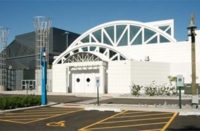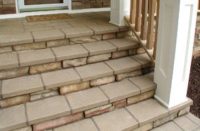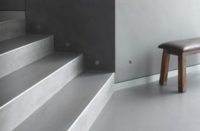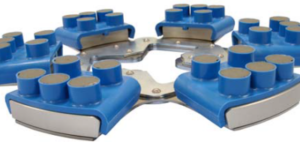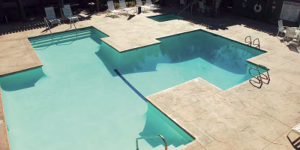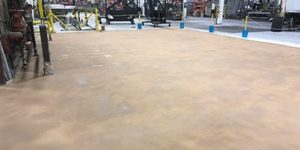 Residential concrete balconies are typically enhanced with paint, carpet, pigmented sealers, ceramic tile, urethane coatings or decorative cements. Each of these options has its advantages and disadvantages. Paint and sealers are inexpensive but are not very durable, show cracks and offer a bland appearance. Carpets cover cracks and can move with decks but must be replaced quite often due to wear, moisture and bacteria growth. Urethane coatings also move with the decks and offer a waterproof barrier, even while bridging small cracks, but they cost more, provide limited decorative options, and sometimes don’t cover imperfections in the substrate. Ceramic tile and stone offer tremendous decorative advantages but do not perform well over cracks, have difficulty with shear bond failure over post-tensioned concrete and usually have a higher installation cost.
Residential concrete balconies are typically enhanced with paint, carpet, pigmented sealers, ceramic tile, urethane coatings or decorative cements. Each of these options has its advantages and disadvantages. Paint and sealers are inexpensive but are not very durable, show cracks and offer a bland appearance. Carpets cover cracks and can move with decks but must be replaced quite often due to wear, moisture and bacteria growth. Urethane coatings also move with the decks and offer a waterproof barrier, even while bridging small cracks, but they cost more, provide limited decorative options, and sometimes don’t cover imperfections in the substrate. Ceramic tile and stone offer tremendous decorative advantages but do not perform well over cracks, have difficulty with shear bond failure over post-tensioned concrete and usually have a higher installation cost.
 Most industry experts agree that decorative cements — including spray textures, stamped overlays, broomed or smooth troweled overlays — offer the best solution for this application. The proper system must be implemented; otherwise, when cracks appear, delamination and moisture intrusion can become major problems. The design and colors are limitless and, if installed properly, will give excellent performance over concrete balcony decks.
Most industry experts agree that decorative cements — including spray textures, stamped overlays, broomed or smooth troweled overlays — offer the best solution for this application. The proper system must be implemented; otherwise, when cracks appear, delamination and moisture intrusion can become major problems. The design and colors are limitless and, if installed properly, will give excellent performance over concrete balcony decks.
Project profile
A condominium project located on the Gulf Coast of Alabama offers some real insight into this particular application of decorative cement toppings. It’s a 15-story luxury condominium building constructed of cast-in-place post-tensioned concrete. Balconies surround the entire building and are rectangular in shape with curved edges.
A polymer-modified base coat and spray texture topping had been installed on approximately 20,000 square feet of decking. Almost 90% of these coated decks were exhibiting cracking in the concrete. Not only were these cracks unsightly, but more important, they caused delamination of the polymer cement and allowed water to penetrate the substrate. In many cases, the cracks were full depth and could be seen on the ceiling of the floor below. An elastomeric “popcorn” type finish had been applied to the balcony ceilings and was also delaminating near the cracks. The cracks extended from the outside edge of the balcony past the window walls and inside the unit, affecting dry wall and carpet. These cracks, and their constant movement, had caused the bond loss on ceramic tiles inside the units as well.
 Two different methods were used to attempt to repair the problem. The first method involved sawing out the crack approximately two inches wide and one inch deep. This was then chipped out and filled with a polymer-modified cement repair mortar and coated back with the original base coat and spray texture. This attempt failed due to the fact that the concrete was still moving on either side of the crack, and subsequently, delamination reappeared.
Two different methods were used to attempt to repair the problem. The first method involved sawing out the crack approximately two inches wide and one inch deep. This was then chipped out and filled with a polymer-modified cement repair mortar and coated back with the original base coat and spray texture. This attempt failed due to the fact that the concrete was still moving on either side of the crack, and subsequently, delamination reappeared.
The second method involved routing out the crack with a 3/8” wide diamond blade or a crack chaser blade. A flexible caulking or sealant was then applied to this joint, followed by a reapplication of the original base coat and spray texture. While this procedure potentially stopped the migration of water into the crack, it too was unsuccessful because the decorative topping did not move with the concrete as much as the caulk and failed when applied over it.
A third repair method was then attempted: A urethane coating was applied on the remainder of the balconies.  A color was selected and the topcoat had a colored aggregate broadcast on the surface for aesthetics and slip resistance.
A color was selected and the topcoat had a colored aggregate broadcast on the surface for aesthetics and slip resistance.
This system was ultimately rejected for two reasons. First, the owner simply didn’t like the way it looked. The color with sand sprinkled over it turned out to look too one-dimensional and had a “plain Jane” appearance. Since the units were to be sold for well over $300,000 each, the owner was not prepared to settle for function over design. Second, the urethane lacked the ability to hide imperfections and broom marks in the concrete, which resulted in an unsightly appearance. Additionally, the urethane was more expensive than the originally specified spray texture. Discussions about applying exterior carpet ensued but were dismissed because of the initial cost, replacement costs and fraying of carpet at the balcony edges.
The Successful Solution
The cracks in the concrete decks were caused by movement of the concrete and also cold joints present from initial placement of the concrete. Finally, a successful repair method was identified. The first step was to rout out all existing cracks and fill them with a semi-rigid epoxy, which allowed slight movement of the concrete. Using a very rigid epoxy sometimes causes another crack to form near the repaired crack. In those instances, reinforcing mesh was applied over the crack and secured by troweling it with excess epoxy. Dried sand was sprinkled over the mesh, and the epoxy allowed the cure. Another layer of reinforcing mesh was then applied and imbedded with a flexible, waterproof, elastomeric cement. Next, the flexible cement and repair mesh was installed over the entire deck. The concrete had essentially been “glued” together at the crack, but allowed slight movement so another crack wouldn’t appear later. The repair mesh reinforced this restricted movement, and the flexible cement prevented moisture intrusion.
 The last step was to choose a decorative topcoat. The original spray topping selected could not be used because of incompatibility with the flexible cement as well as its limited amount of flexibility. Consequently, a compatible polymer-modified spray system was selected instead. The base color and colored aggregate were closely matched to the original specified product. Two coats of clear acrylic sealer were applied to complete the project.
The last step was to choose a decorative topcoat. The original spray topping selected could not be used because of incompatibility with the flexible cement as well as its limited amount of flexibility. Consequently, a compatible polymer-modified spray system was selected instead. The base color and colored aggregate were closely matched to the original specified product. Two coats of clear acrylic sealer were applied to complete the project.
The decorative concrete industry has created excellent products to beautify concrete, and their use has grown exponentially. More innovations in applications and systems will help solidify these products as alternatives to traditional (improperly specified) repair methods and materials.
For more information on the repair and resurfacing products used please call CEMTEC Repair and Resurfacing at 706-654-4706.
The decorative concrete contractor for this project was Flexible Concrete Surfacing Systems, Inc.. They can be reached at 404-925-4251.
